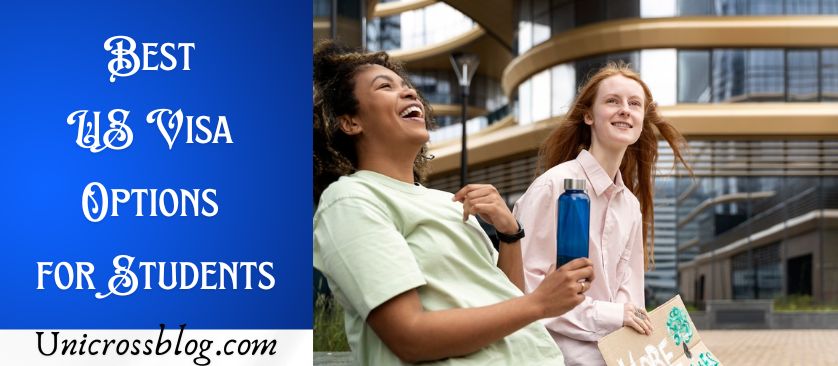As an international student considering studying in the United States, navigating the complex visa system can be overwhelming. With multiple options available, each with its own requirements and limitations, how do you determine which visa is best suited for your educational goals?
This comprehensive guide will walk you through the top US visa options for students, ranking them based on factors like eligibility criteria, duration of stay, and work opportunities. By understanding the pros and cons of each visa type, you’ll be better equipped to make an informed decision and embark on your American educational journey with confidence.

Best US Visa Options for Students: A Ranked List
1. F-1 Student Visa: The Gold Standard
For international students looking to pursue academic studies in the United States, the F-1 visa is the top choice. This non-immigrant visa is specifically intended for full-time students enrolled in academic programs or language training schools. The F-1 visa has several advantages, making it the preferred option for most international students.
One of the key benefits of the F-1 visa is its flexibility. It allows students to study at any accredited educational institution in the U.S., from community colleges to prestigious universities. Moreover, F-1 visa holders can often work on-campus for up to 20 hours per week during the academic year and full-time during breaks, providing valuable work experience and financial support.
Another significant advantage is the option for Optional Practical Training (OPT). This program allows students to work in their field of study for up to 12 months after graduation, with STEM students eligible for an additional 24-month extension. This opportunity to gain real-world experience in the U.S. job market is invaluable for career development and can often lead to long-term employment opportunities.
2. J-1 Exchange Visitor Visa: Cultural Exchange and Academic Pursuit
The J-1 visa ranks second on our list, offering a unique blend of cultural exchange and academic opportunities. This visa is ideal for students participating in exchange programs, short-term study abroad experiences, or specialized training programs.
One of the standout features of the J-1 visa is its emphasis on cultural exchange. Participants are encouraged to engage in activities that promote mutual understanding between the U.S. and their home countries. This can include language teaching, research, or specialized training in various fields.
The J-1 visa also offers work opportunities, with many programs including internships or job placements as part of the exchange experience. However, it’s important to note that some J-1 visas come with a two-year home residency requirement, mandating that participants return to their home country for two years after completing their program before being eligible for certain U.S. visas.
3. M-1 Vocational Student Visa: Specialized Skills Training
For students interested in vocational or non-academic programs, the M-1 visa is the go-to option. This visa is designed for those pursuing technical or vocational training in fields such as culinary arts, aviation, or cosmetology.
The M-1 visa is more restrictive than the F-1 visa in terms of work opportunities and length of stay. Students on an M-1 visa are typically limited to programs lasting no more than one year, with the possibility of extension in certain circumstances. While M-1 students cannot work off-campus during their studies, they may be eligible for up to six months of practical training after completing their program.
Despite these limitations, the M-1 visa remains an excellent choice for students seeking specialized, hands-on training in specific vocational fields. It provides a focused pathway for those looking to acquire practical skills in a relatively short time frame.
4. H-4 Dependent Visa: A Gateway for Family Members
Although it is not primarily a student visa, the H-4 visa is worth mentioning as a viable option for dependents of H-1B visa holders who wish to study in the U.S. Spouses and unmarried children under the age of 21 of H-1B workers can obtain H-4 visas, which allow them to live in the U.S. and enroll in full-time study programs.
The main advantage of the H-4 visa for students is that it doesn’t come with the same restrictions as dedicated student visas. H-4 visa holders can study part-time or full-time without needing to maintain a specific course load. However, it’s important to note that H-4 visa holders are generally not permitted to work in the U.S., which can be a significant drawback for those seeking employment opportunities alongside their studies.
In conclusion, while the F-1 visa remains the top choice for most international students, each visa option has its unique advantages and limitations. Your ideal visa will depend on your specific educational goals, desired length of stay, and long-term plans in the United States. Always consult with an immigration attorney or your school’s international student office for the most up-to-date and personalized advice on visa options.
READ ALSO: Highly-Funded Visa Options For Digital Nomads
FAQs
What is the difference between F-1 and J-1 visas?
The F-1 and J-1 visas are two of the most common options for international students in the U.S., but they have distinct purposes and requirements. The F-1 visa is primarily for students pursuing full-time academic studies at accredited U.S. institutions. It allows for limited work opportunities, mainly on-campus, and requires students to maintain a full course load.
In contrast, the J-1 visa is designed for exchange visitors participating in approved programs. This can include students but also extends to scholars, professors, and research assistants. J-1 visa holders often have more flexibility in terms of work authorization but may be subject to a two-year home residency requirement after completing their program.
How long can I stay in the U.S. on a student visa?
The duration of stay on a student visa depends on the program length and visa type. For F-1 visa holders, you can typically remain in the U.S. for the duration of your academic program, plus an additional 60 days (known as the “grace period”). J-1 visa holders’ stay is determined by their program end date, plus a 30-day grace period.
It’s crucial to note that these timeframes are not guaranteed. Your authorized stay is recorded as “Duration of Status” (D/S) on your I-94 form. This means you can remain in the U.S. as long as you maintain your student status and continue making normal progress towards completing your course of study.
Can I work while studying on a student visa?
Work opportunities for international students are limited and strictly regulated. F-1 visa holders can work on-campus for up to 20 hours per week during the academic year and full-time during breaks. After the first academic year, you may be eligible for off-campus employment through Curricular Practical Training (CPT) or Optional Practical Training (OPT).
J-1 students may be allowed to work on or off campus, depending on the specifics of their exchange program. However, all employment must be authorized in advance by their program sponsor.
Remember, unauthorized work can lead to severe consequences, including visa revocation and deportation. Always consult with your school’s international student office before accepting any employment.
What happens if I want to change my course or institution?
If you’re considering changing your course or institution, it’s essential to follow proper procedures to maintain your visa status. F-1 students can usually transfer to another SEVP-certified school or change their program of study at the same institution without applying for a new visa. However, you must obtain approval from your current school’s Designated School Official (DSO) and the new school’s DSO.
For J-1 students, the process can be more complex. You may need to obtain approval from your program sponsor and, in some cases, apply for a new visa. It’s crucial to consult with your program sponsor or the international student office well in advance of any planned changes.
Can I travel outside the U.S. during my studies?
Yes, you can travel outside the U.S. during your studies, but it’s important to plan carefully. Ensure your visa and passport are valid for re-entry, and obtain a travel signature on your I-20 (for F-1 students) or DS-2019 (for J-1 students) from your DSO or program sponsor. This signature is typically valid for one year.
Be aware that extended absences or travel to certain countries may require additional documentation or screening upon re-entry. Always check the current travel advisories and entry requirements before planning your trip. It’s also wise to carry proof of your ongoing studies and financial support when re-entering the U.S.







